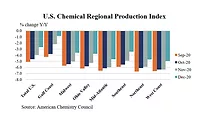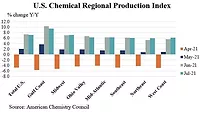ACC’s Chemical Activity Barometer Falls in August

WASHINGTON – The Chemical Activity Barometer (CAB), a leading economic indicator created by the American Chemistry Council (ACC), fell 0.5% in August on a three-month moving average (3MMA) basis following steadily easing gains in May, June and July. On a year-over-year (Y/Y) basis, the barometer rose 12.5% in August (3MMA).
The unadjusted data show a 1.6% decline in August after flat readings in July and June. The diffusion index eased to 82% in August. The diffusion index marks the number of positive contributors relative to the total number of indicators monitored. The CAB reading for July was revised downward by 0.53 points and the reading for June was revised downward by 0.33 points. The August data are provisional and subject to revision.
“The latest CAB reading is consistent with expansion of commerce, trade and industry, but clearly growth has peaked, with slower growth ahead,” said Kevin Swift, Chief Economist at ACC.
The CAB has four main components, each consisting of a variety of indicators: production, equity prices, product prices, and inventories and other indicators.
In August, production-related indicators were up slightly. Trends in construction-related resins and related performance chemistry improved. Resins and chemistry used in other durable goods increased. Plastic resins used in packaging and for consumer and institutional applications showed gains. Performance chemistry for industry was solid and exports grew. Equity prices declined amid geopolitical uncertainty and fears about the Delta variant. Product and input prices expanded. Inventory and other supply chain indicators were positive.
The CAB is a leading economic indicator derived from a composite index of chemical industry activity. Due to its early position in the supply chain, chemical industry activity has been found to consistently lead the U.S. economy’s business cycle, and the barometer can be used to determine turning points and likely trends in the broader economy. Month-to-month movements can be volatile, so a three-month moving average of the CAB reading is provided. This provides a more consistent and illustrative picture of national economic trends.
The CAB comprises indicators relating to the production of chlorine and other alkalies, pigments, plastic resins and other selected basic industrial chemicals; chemical company stock data; hours worked in chemicals; publicly sourced, chemical price information; end-use (or customer) industry sales-to-inventories; and several broader leading economic measures (building permits and new orders). Each month, ACC provides a barometer number reflecting activity data for the current month, as well as a three-month moving average. The CAB was developed by the Economics Department at ACC.
Learn more at: https://www.americanchemistry.com/chemistry-in-america/news-trends.
Looking for a reprint of this article?
From high-res PDFs to custom plaques, order your copy today!







